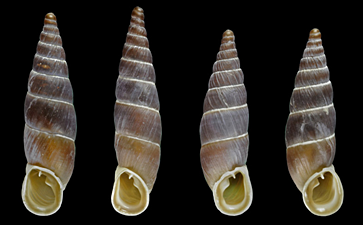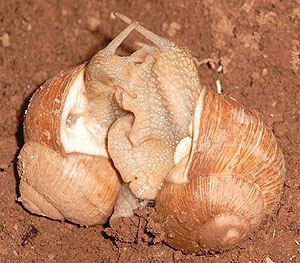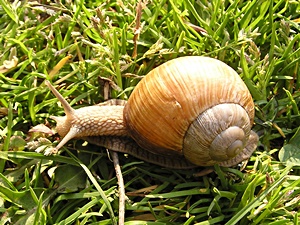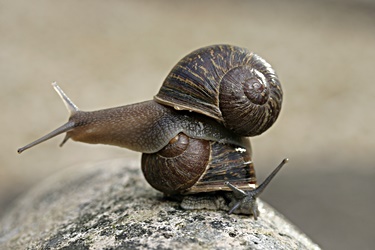| Diese Seite auf Deutsch! |
|
Snail Kings - Sinistral Roman Snails |
 Left Fuchs' Door Snail (Alopia straminicollis) and Right Fuchs' Door Snail (Alopia livida) from the Velikan valley (Bucegi, Romania). Picture: Sigrid Hof (Source: hnords.de). |
The importance of the shell coiling direction in snails has sufficiently been documented on this homepage. To summarise, most snail species' shells are coiled in one direction specific for the respective species. So Helicidae snails are coiled to the right (dextral), door snails (Clausiliidae, e.g. Cochlodina laminata oder Macrogastra ventricosa) are coiled to the left (sinistral), whereas some other door snail species (e.g. Alopia livida, contrary to Alopia straminicollis) are dextral.
The exception is if specimens of a usually dextral species, such as the Roman snail (Helix pomatia) are sinistral. This extremely rare phenomenon only occurs with one in several thousand snails. In the well-known case of the Roman snail, this is colloquially known as a snail king.
![]() Benecke,
M. (1994): Von Schneckenkönigen, ungehörnten Würmern und schmatzenden Fischen.
Zur Systematik des Conchylienreiches. Club Conchylia 26(2):11-15. (in German).
Benecke,
M. (1994): Von Schneckenkönigen, ungehörnten Würmern und schmatzenden Fischen.
Zur Systematik des Conchylienreiches. Club Conchylia 26(2):11-15. (in German).
 A rare picture: A snail king (right) mating with a dextral Roman snail. Picture Peter Leonhardt (Felix-Helix-Project). |
Related to the inversely coiled shell, e.g. the genital opening if a sinistral snail is on the "wrong" side of the body as well. This makes the mating procedure with a commonly dextral snail a bit cumbersome. While the pre-mating process (as shown in the picture on the left) takes place the intended way, both snails have to twist their upper bodies to reach each other's genital pores, so copulation can take place.
Since snail kings are rarely found in the wild, such findings usually are mentioned in the daily media:
![]() Seltener Fund - Der
Brunner Schneckenkönig (MeinBezirk.at,
Accessed 21.08.2022).
Seltener Fund - Der
Brunner Schneckenkönig (MeinBezirk.at,
Accessed 21.08.2022).
![]() Rarität: Auch Schnecken haben Könige (DiePresse.com,
Accessed 21.08.2022).
Rarität: Auch Schnecken haben Könige (DiePresse.com,
Accessed 21.08.2022).
It is only owed to an incredible coincidence, if, like with Karin and Peter Leonhardt, someone finds not one but two snail kings not far away from each other. The exact circumstances can be read on Karin and Peter Leonhardt's homepage, albeit only in German.
![]() Karin and Peter Leonhardt: Felix-Helix-Project
(Accessed 21.08.2022).
Lahn
King,
Moselle
King.
Karin and Peter Leonhardt: Felix-Helix-Project
(Accessed 21.08.2022).
Lahn
King,
Moselle
King.
 A Roman snail king (Helix pomatia). Compared to a dextral Helix lucorum as proof. Pictures: Robert Nordsieck. |
There are good chances, however, to find a snail king on a snail farm, since there is a very large number of snails on such farms. The snail king "Elvis shown in the picture on the right, was obtained in 2007 from the German Institute for Heliciculture in Nersingen near Neu-Ulm.
It is not surprising, however, that snail kings are hardly ever found in the wild. On one hand, they are extremely rare from the start. On the other, especially juvenile snails are subject to a large amount of prey pressure, which means only a small number of them reach adult age and can reproduce.
The genetic basis of snail shell coiling direction has not been documented very well for a long time, also because the chemical basis of genetic information was known only to a little extent until the beginning of the 20th century.
Using the principles of Mendelian genetics, it would have to be assumed that a snail shell's coiling direction was determined by a dominant-recessive heredity. That would mean the attribute 'sinistrality' was the recessive one, which, in the case of mixed heritage, would be suppressed by the wild-type attribute (called an allele). However, if two dextral snails mate, the offspring can be exclusively sinistral. That cannot be explained by a common dominant-recessive heredity.
 Alfred H. Sturtevant (1891 - 1970). Source: Prabook. |
In 1923, the American geneticist Alfred Henry Sturtevant published his studies in an article in the magazine Science, in which he concluded that snail shell's coiling direction (he examined pond snails Radix labiata, Lymnaea peregra at the time) was indeed inherited following a dominant-recessive pattern.
![]() Sturtevant, A.H.
(1923): Inheritance of direction of coiling in Limnaea. Science 58, 269-270. (Link).
Sturtevant, A.H.
(1923): Inheritance of direction of coiling in Limnaea. Science 58, 269-270. (Link).
What direction a snail's shell was coiled in, he determined, depended on what
side the mitosis spindle was tilted to (![]() Diagram). The genetic basis of the mitosis
spindle's development, however, was determined by the mother's genome (in the case
of those snails being hermaphrodites, the animal the eggs originated from), and not by
the developing embryo's genome.
Diagram). The genetic basis of the mitosis
spindle's development, however, was determined by the mother's genome (in the case
of those snails being hermaphrodites, the animal the eggs originated from), and not by
the developing embryo's genome.
Thus, what was important for snail shells' coiling direction heredity, was the mother's genome and not the snail's own - this is called a maternal effect or a matrocline heredity. This would also explain, why a dextral snail could have sinistral offspring. While being externally (phenotypically) dextral, it had to be genotypically homozygously carrier of the recessive attribute "sinistrality", which led to sinistral offspring
![]() The Genetics of Shell Coiling
or: Why Are Snail Kings Especially Rare?
The Genetics of Shell Coiling
or: Why Are Snail Kings Especially Rare?
Literature on genetic basics::
![]() Bresch, C.; Hausmann,
R.: Klassische und molekulare Genetik, 3. Ed., Springer Verlag Berlin, 1972.
Bresch, C.; Hausmann,
R.: Klassische und molekulare Genetik, 3. Ed., Springer Verlag Berlin, 1972.
![]() Sturtevant, A. 1923. Inheritance of direction of coiling in
Limnaea.
Science 58: 269-270.
Sturtevant, A. 1923. Inheritance of direction of coiling in
Limnaea.
Science 58: 269-270.
![]() Sturtevant, A. H.; Lewis, E. B.: "A
History of Genetics" (2001).
Sturtevant, A. H.; Lewis, E. B.: "A
History of Genetics" (2001).
 Snail king "Jeremy" (top). Picture: Angus Davison. Source: Wikipedia. |
British geneticist Angus Davison
in the course of the latest decade has studied shell coiling in snails. In doing
so he was able to prove, that a specific cell structure protein, Formin,
determined what side internal organs would be placed on in frogs
as well as in snails It determined the direction of the mitosis spindle's tilt (![]() Diagram)
during the 3rd cell cleavage during embryonic development, and thus in
snails the direction the shell was coiled in.
Diagram)
during the 3rd cell cleavage during embryonic development, and thus in
snails the direction the shell was coiled in.
![]() Davison, A. et al.
(2016):
Formin Is Associated with Left-Right Asymmetry in the Pond Snail and the Frog.
Current Biology 26/7.
Davison, A. et al.
(2016):
Formin Is Associated with Left-Right Asymmetry in the Pond Snail and the Frog.
Current Biology 26/7.
When then in Southwest London a rare left coiled common garden snail (Cornu aspersum) was found and had been named Jeremy, using the hashtag #snaillove, Davison started a search via the internet for potential sinistral mating partners.
This search was rather successful. Davison was sent several snail kings, from France, Spain, Great Britain and other countries. Several of those snails came from snail farms.
![]() Kristen
Rogers:
Two lefties make a right, if you're a rare garden snail (edition.cnn.com
03.06.2020, accessed 21.08.2022).
Kristen
Rogers:
Two lefties make a right, if you're a rare garden snail (edition.cnn.com
03.06.2020, accessed 21.08.2022).
The snails consequently were catalogued and mated by Davison and his team. Davison assumed the snails would have to be unfertilized since snail kings hardly ever mated with dextral partners in nature, this being too complicated due to the mirrored placement of organs. Copulations, however, do take place, which Karin and Peter Leonhardt (see above) had been able to observe. While this rarely happens in the wild due to the rareness of snail kings, it is certainly possible in snail farms, where 80% of the snails (12 out of 15) came from.
The matings resulted in exclusively dextral snails. After a further generation of matings, in the F2 generation, 17 sinistral snails hatched from two French snails in the F0 generation. All other of the 6287 F2 generation snails were dextral (Table 1 in Davison et al. (2020)).
As a result of these studies, Davison concludes that shell coiling heredity in Cornu aspersum snails does not take place due to genetic factors, but because of changes (e.g. environmentally induced) in the mitosis spindle's tilting direction during the the fertilised cell's 3rd cleavage.
![]() Bantock, C.R., Noble, K., Ratsey, M. (1973):
Sinistrality in Cepaea hortensis. Heredity 30, 397-398.
(Link,
accessed 12.08.2022)
Bantock, C.R., Noble, K., Ratsey, M. (1973):
Sinistrality in Cepaea hortensis. Heredity 30, 397-398.
(Link,
accessed 12.08.2022)
![]() Davison, A.,
Thomas, P. et al. (2020): Internet
'shellebrity' reflects on origin of rare
mirror-image snails. The Royal Society: Biol. Lett. 16:6
(Link,
accessed 12.08.2022).
Davison, A.,
Thomas, P. et al. (2020): Internet
'shellebrity' reflects on origin of rare
mirror-image snails. The Royal Society: Biol. Lett. 16:6
(Link,
accessed 12.08.2022).
![]() Davison, A.,
(2020): Flipping shells: unwinding LR asymmetry in mirror-image molluscs. Trends
Genet. 36, 189-202. (Link,
accesssed 12.08.2022).
Davison, A.,
(2020): Flipping shells: unwinding LR asymmetry in mirror-image molluscs. Trends
Genet. 36, 189-202. (Link,
accesssed 12.08.2022).
![]() Shinju University:
Right- or left-handed? Gene expression tells the story of snail evolution
(Accessed 22.08.2022).
Shinju University:
Right- or left-handed? Gene expression tells the story of snail evolution
(Accessed 22.08.2022).